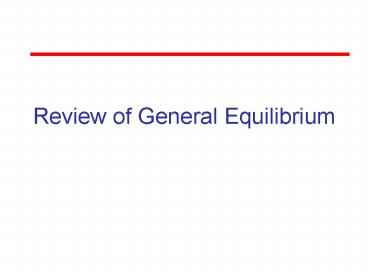Review of General Equilibrium PowerPoint PPT Presentation
1 / 22
Title: Review of General Equilibrium
1
Review of General Equilibrium
2
Structure
- Review of general equilibrium model
- Reading
- Krugman Obstfeld
- 2nd or 3rd year micro text
3
General equilibrium requirements
- Consumers make optimal choices given product
prices They maximise utility - Producers make optimal choices given product
prices and factor prices (costs) they maximise
profits - For general equilibrium Production consumption
- If production ? consumption, then prices adjust
to ensure equilibrium
4
General equilibrium in closed economy
5
General Equilibrium
- Review
- Efficiency condition (Consumption)
- MRSAxy MRSBxy PX/PY
- 2. Efficiency condition (Production)
- MRTSX MRTSY MPLX/MPKX MPLY/MPKY
- 3. Efficiency condition (Product mix)
- MRTXY - DY/DX MPLY/MPLX MPKY/MPKX
PX/PY
6
(1) Consumer Optimization
- Perfectly competitive markets
- U U(X,Y) subject to I PXX PYY
- Optimization
- where ratio of marginal utilities equals price
ratio - Single consumer
- Ux/UY PX/PY MRS
- Note Ux/UY is the Marginal rate of
substitution (MRS)
7
Consumer Optimization
- Indifference Curve All possible combinations of
good X and good Y which yield the same level of
satisfaction - Budget line I PXX PYY Y I/PY
PX/PYX
Y
IC3
IC2
IC1
X
8
Consumer Optimization two consumers
- What is the optimisation relationship when we
have two consumers? - If PX/PY is fixed, then both consumers will
optimise such that - Ux/UY PX/PY
- Ux/UY PX/PY
- i.e MRSA MRSB PX/PY (1)
- Quantity consumed of X and Y will adjust to
ensure the equilibrium condition (1) holds - BUT if we have a fixed quantity of X and Y, then
prices will adjust such that the equilibrium
condition (1) holds
9
Consumer Optimization 2 consumers
- Edgeworth Box
- At A MRSPaul gt MRSSam
- At B MRSPaul MRSSam PX/PY
0Sam
QY
A
B
PX/PY
0paul
QX
10
(2) Producer Optimization
- Perfectly competitive markets single producer
- Maximize Qx F(K,L) subject to C0 wL rK
- Thus
- optimization when wage-rental ratio is equal to
the slope of an isoquant -DK/DL MPL/MPK w/r - (Production Efficiency Condition)
11
Producer Optimization
- Isoquant All possible combinations of capital
and labour that could be used to produce a
particular quantity of X - Qx MPLXL MPKXK
- Isocost C0 wL rK K C0/r w/rL
KX
Implies at equilibrium MPLX/MPKX w/r
C0/r
X 200
X 150
X 100
LX
12
Producer Optimization
- At H MRTSX gt MRTSY MPLX/MPKX gt
MPLY/MPKY - X has too much capital, too little labour, Y has
too much labour , too little capital gtgtgt
reallocation of capital labour can increase
output - At E MRTSX MRTSY w/r MPLX/MPKX
MPLY/MPKY
0Y
K
200
240
180
H
A
100
C
80
D
150
200
240
0X
L
13
(3) Product Mix
- Contract curve (Producer Optimization) and PPF
(Production Possibility Frontier)
Y
Slope - DY/DX or opportunity cost of producing 1
more unit of X in terms of Y forgone
A
240
B
200
150
C
- DY/DX
80
D
X
100
240
180
200
14
(3) Product Mix
- Producing an efficient output mix involves
balancing the subjective wants, or preferences
(MRS of consumers) with the objective conditions
of production
15
(3) Product Mix
- Perfectly competitive markets Two-good,
two-factor model - Qx Fx(Kx,Lx) QY FY(KY,LY)
- Factor market equilibrium (supply demand)
- K Kx KY and L Lx LY
- Profit maximisation condition
- w MPLXPX r MPKXPX (1)
- w MPLYPY r MPKYPY (2)
- Rearrange (1) into (2) PX/PY MPLY/MPLX
MPKY/MPKX - But MPLY DY/DLY where DLY -DLX
- MPLX DX/DLX
- Thus MPLY/MPLX -DY/DX MRT
PX/PY
16
(3) Product Mix
- Assume that the Market price (Px/Py) 5. What is
the incentive to shift from A to C?
Px/Py5
Y
A
240
B
200
150
C
80
D
X
100
240
180
200
17
(3) Product Mix
(1) Producer optimisation MRTSXMRTSY (i.e. on
contract curve)
Y
A
240
B
200
150
C
80
D
X
100
240
180
200
18
Question
Assume Px/Py 4 at B. Explain the adjustment to
consumers, producers and general equilibrium when
relative Px/Py falls to 2.
Y
A
240
B
200
150
C
PX/PY
80
D
X
100
240
180
200
19
Additional slides
20
Production function
- Qx F(K,L) Certain technology (F), which
requires a combination of capital (K) and labour
(L), can produce some quantity of good X (Qx). - Assume fixed capital (K0) gtgt Law of Diminishing
Returns
F(K0,L)
Qx
L
MPLX
L
21
Producer Optimization
- Marginal Rate of Technical Substitution
- MRTSA MPL1/MPK1 gt MPL2/MPK2 MRTSB
K
A MPL1gt MPK1
K1
B MPL2lt MPK2
K2
L
L2
L1
22
Producer Optimization
- Optimization where isoquant is tangent to
isocost - MRTS MPL/MPK w/r
- Isoquant
- DQX (MPL)DL (MPK)DK With DQX 0
- (MPL)DL - (MPK)DK MPL/MPK -DK/DL (1)
K
Isocost C0 wL rK DC0 wDL rDK With DC0
0 wDL - rDK w/r -DK/DL (2)
w/r MPL/MPK
Kop
L
Lop

